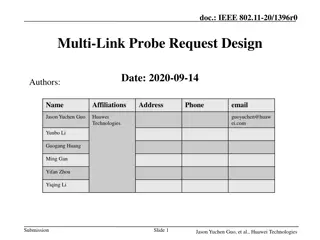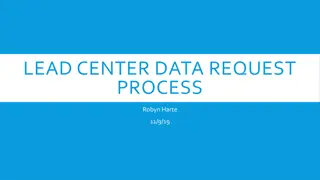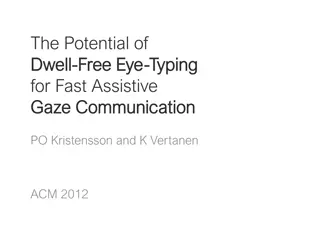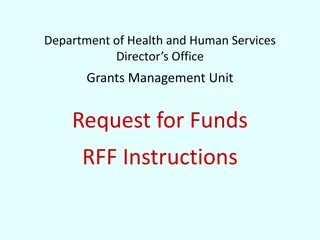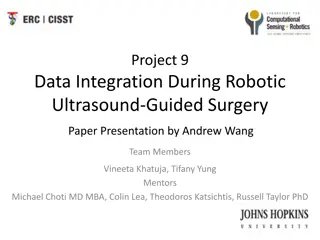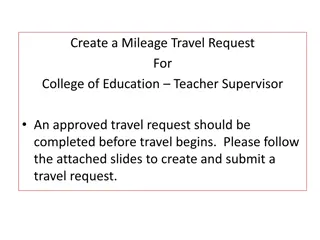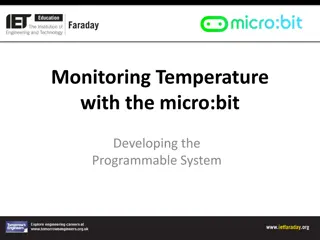Dwell Time In Probe Request Presentation
This document discusses the communication of client channel dwell time in dense WiFi environments using IEEE 802.11 standards. It addresses the optimization of airtime utilization in congested settings, focusing on the impact of probe requests, probe responses, and off-channel scans. The study includes analysis and solutions for managing high-density WiFi installations, specifically in a stadium environment with multiple access points. The importance of transmitting dwell time information in probe requests to mitigate airtime consumption is highlighted, along with insights into AP placement strategies for better client connectivity.
Download Presentation

Please find below an Image/Link to download the presentation.
The content on the website is provided AS IS for your information and personal use only. It may not be sold, licensed, or shared on other websites without obtaining consent from the author.If you encounter any issues during the download, it is possible that the publisher has removed the file from their server.
You are allowed to download the files provided on this website for personal or commercial use, subject to the condition that they are used lawfully. All files are the property of their respective owners.
The content on the website is provided AS IS for your information and personal use only. It may not be sold, licensed, or shared on other websites without obtaining consent from the author.
E N D
Presentation Transcript
May 2016 doc.: IEEE 802.11-16/0587r0 Dwell Time In Probe Request Presentation Date: 2016-05-16 Authors: Name Peter Khoury Affiliations Address Ruckus Wireless Phone +1.415.517.8715 email Peter.khoury@ruckuswire less.com peat@curious-peter- george.com mark.hamilton2152@gma il.com 350 West Java Drive, Sunnyvale, CA 94089, USA +1.303.818.8472 350 West Java Drive, Sunnyvale, CA 94089, USA 350 West Java Drive, Sunnyvale, CA 94089, USA Mark Hamilton Ruckus Wireless +1.408.348.3171 stuart@ok-brit.com Stuart Kerry Ruckus Wireless Submission Slide 1 Peter Khoury, Ruckus Wireless
May 2016 doc.: IEEE 802.11-16/0587r0 Abstract Communication of client channel dwell time (aka MaxChannelTime) in Probe Requests during active channel scanning will decrease the amount of airtime consumed by management frames in a congested environment. Submission Slide 2 Peter Khoury, Ruckus Wireless
May 2016 doc.: IEEE 802.11-16/0587r0 Characterization of Rio Tinto Stadium Environment Salt Lake City Soccer Stadium ~80APs in bowl ~105APs total (for concessions and infrastructure) ~20k seat capacity Full during testing -> ~10k clients We analyze WiFi data sniffed in this environment and take it to be representative of a High Density WiFi installation. Submission Slide 3 Peter Khoury, Ruckus Wireless
May 2016 doc.: IEEE 802.11-16/0587r0 Airtime Utilization in High Density Environment Management Traffic can consume substantial amounts of airtime. Beacons up to 8-9% Probe Responses up to 9- 10% Probe Requests - % Utilization depends on AP placement APs placed in the center of the stadium hear more clients and other APs. Submission Slide 4 Peter Khoury, Ruckus Wireless
May 2016 doc.: IEEE 802.11-16/0587r0 Probe Response Problem in Congested Network If an AP cannot successfully transmit a Probe Response in the client Off Channel Scan dwell time, a significant amount of airtime may be consumed for Probe Response management traffic by APs transmitting to a client that has changed channels. Serving AP Data Traffic Data Traffic Client Active Off Channel Scan Broadcast Probe Request Probe Rsp AP2 SSID_A Probe Rsp AP1 SSID_C Probe Rsp AP1 SSID_A Probe Rsp AP1 SSID_B Neighboring AP1 Neighboring AP2 Submission Slide 5 Peter Khoury, Ruckus Wireless
January 2016 Probe Request Solution to Problem doc.: IEEE 802.11-16/0587r0 Problem is solved by the transmission of dwell time, MaxChannelTime, in the broadcast Probe Request. AP2 will not send Probe Responses unnecessarily. Exists in 802.11ai standard but is optional. Serving AP Data Traffic Data Traffic Client Active Off Channel Scan Probe Rsp AP1 SSID_A Probe Rsp AP1 SSID_C Probe Rsp AP1 SSID_B Request w Dwell Time Broadcast Probe Neighboring AP1 Neighboring AP2 Dwell Time MaxChannelTime Submission Slide 6 Peter Khoury, Ruckus Wireless
May 2016 doc.: IEEE 802.11-16/0587r0 Overhead Load vs Benefit Worst case adding entire FILS Request element is 5 octets additional overhead 2% per Probe Request. Really adding only 1 octet of additional overhead for station already sending FILS Element. This is increase of % overhead. When the Probe Request overhead increases by - 2% to break even on overall management overhead we only need to prevent the transmission of 1 to 4 Probe Responses out of 200. From the airtime utilization analysis in slide 4 the ratio of Probe Response to Probe Request airtime is 13 14. This high ratio gives us an excellent opportunity for a sizable reduction in management traffic. Submission Slide 7 Peter Khoury, Ruckus Wireless
May 2016 doc.: IEEE 802.11-16/0587r0 Client Variation in Active Scan Implementation Provides Opportunity for Benefit The needed elimination of 1 4 Probe Responses in 200 sets a very low bar for overall gain. Client implementation of active off channel scanning is not standardized and therefore varies from implementation to implementation. MaxChannelTime is not fixed or even known by AP vendors. AP wants to ensure reception of its Probe Response so that client will stop scanning. But transmitting for the longest MaxChannelTime that accommodates one client may waste transmissions for a client that has a shorter MaxChannelTime. Submission Slide 8 Peter Khoury, Ruckus Wireless
May 2016 doc.: IEEE 802.11-16/0587r0 Client Variation in Active Scan Implementation Provides Opportunity for Benefit In a congested network, Probe Responses have been observed to consume 9-10% of the total air time. Within a congested network, Probe Responses egress are likely to be delayed and an active scanning client will probably no longer on channel. Typical networks have multiple BSSIDs, so this repeats for multiple Probe Responses per (broadcast) Probe Request. Multiplied again, by the number of retries the AP will use for each failed attempt, likely means more than 10 wasted transmissions for a single event. If we can save 1 Probe Response per 200, the additional overhead of MaxChannelTime transmission is worth it. Submission Slide 9 Peter Khoury, Ruckus Wireless
May 2016 doc.: IEEE 802.11-16/0587r0 Summary The mandatory inclusion of this simple field with very little overhead and little implementation complexity will provide a substantial reduction in management overhead in a high density environment. Submission Slide 10 Peter Khoury, Ruckus Wireless








